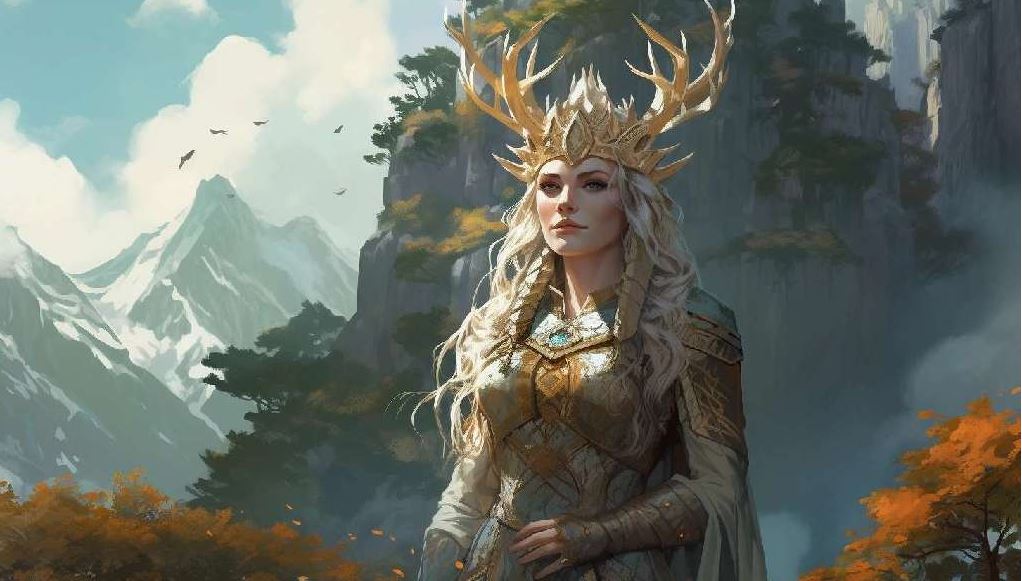Norse Goddess Sjofn: The Divine Patroness of Love and Romance

Norse Goddess Sjofn, the embodiment of love and romance in Norse mythology, holds a significant role among the deities. Her association with elves and goddesses adds depth to her character. Mentioned in Snorri Sturluson’s Prose Edda, Sjofn’s attributes and duties are vividly described, highlighting her connection with both lust and affection.
Scholars like John Lindow have analyzed and provided insights into Sjofn’s significance, while she continues to inspire contemporary literature, visual arts, and popular culture. Worship and rituals honoring Sjofn are practiced historically and can be incorporated into personal spiritual practices today.
Numerous questions and misconceptions surround this enigmatic goddess, creating an intriguing field of exploration.
The Origin and Meaning of Norse Goddess Sjofn
Sjofn, the Norse goddess of love and romance, holds a significant place within Norse mythology. This section explores her origins, role in mythology, the etymology of her name, and her association with elves and other goddesses.
The Role of Sjofn in Norse Mythology
Sjofn plays a vital role as one of the twelve handmaidens of the queen of the gods, Frigga. Her primary task is to promote love and strengthen romantic and familial bonds among individuals.
Sjofn acts as a guiding force, directing people’s hearts towards love and fostering peace. She also serves as a messenger for Frigga, aiding in communication.
Etymology of the Word ‘Sjofn’
The name ‘Sjofn’ derives from the ancient Norse language and carries the meaning of ‘affection.’ This etymological connection further emphasizes her role as a promoter and protector of love, particularly within relationships and families.
Sjofn’s Association with Elves and Goddesses
Sjofn’s association with elves adds a mystical aspect to her character. It is believed that she grew up isolated in Alfheim and learned to bring life to toys with her magical abilities under the guidance of the Lady Wind of the South.
These associations highlight the interconnectedness and overlapping roles of various Norse deities.
Sjofn in Norse Literature: Snorri Sturluson’s Prose Edda
In Snorri Sturluson’s Prose Edda, Sjofn is briefly mentioned among the Norse deities, shedding some light on her role in the mythological pantheon. The Prose Edda, a collection of Old Norse writings, provides valuable insights into Norse mythology and the gods and goddesses worshipped during that time.
Sjofn’s Mention in Snorri Sturluson’s Prose Edda
Sjofn receives a brief mention in the Prose Edda, highlighting her significance among the Norse deities. While not extensively described, her presence in the surviving texts indicates the importance attributed to her role as a goddess.
Snorri’s Description of Sjofn’s Attributes and Duties
Although Snorri Sturluson’s Prose Edda does not provide a detailed description of Sjofn’s attributes and duties, her role as a goddess associated with love and affection is implied. As the dedicated companion of Frigga, the queen of the gods, Sjofn promotes love between individuals, safeguards marital commitments, and strengthens familial and romantic bonds.
Sjofn and Love: The Relationship with Lust and Affection
Sjofn’s association with both lust and affection further highlights her multifaceted role in Norse mythology. While promoting love and romance, she also helps maintain a balance between the passionate and tender aspects of relationships.
Her influence extends to facilitating peace and emotional connections, particularly among children and their parents, as well as fostering first teenage loves.
Sjofn’s role as a guardian of affection underscores her importance in nurturing healthy, loving relationships. Through her domain of love, she guides individuals in the pursuit of fulfilling connections and serves as a protector of bonds, whether they be between family members or romantic partners.
Interpretations and Insights from Scholars
The scholarly community has delved into the realm of Norse mythology to uncover the deeper meanings behind the enigmatic Norse goddess Sjofn. Through their analysis and interpretations, various insights have emerged regarding her role and significance in the Norse pantheon.
John Lindow’s Analysis of Sjofn’s Role
Prominent scholar John Lindow has extensively studied Sjofn and shed light on her importance within Norse mythology. Lindow emphasizes Sjofn’s association with promoting love and affection, highlighting her role in strengthening emotional connections between individuals and fostering harmonious relationships.
According to Lindow, Sjofn goes beyond mere romantic love and encompasses familial bonds, friendships, and even self-love. This broader understanding showcases the depth of Sjofn’s influence on interpersonal relationships.
Other Scholarly Perspectives on Sjofn’s Importance
In addition to Lindow’s analysis, other scholars have contributed their perspectives on the significance of Sjofn. Some emphasize her connection to fertility and the creation of new life, drawing parallels between her role and the flourishing of relationships.
Others explore Sjofn’s connection to feminine power, considering her an embodiment of nurturing and caring qualities. These varied interpretations highlight the multifaceted nature of Sjofn’s influence and how different aspects contribute to her overall significance in Norse mythology.
Critiques and Alternative Interpretations
While Sjofn’s role as a promoter of love and affection is widely recognized, some scholars have offered alternative viewpoints and critiques of traditional interpretations. These dissenting voices question the portrayal of Sjofn as solely focused on positive emotions, suggesting that she may also have a role in navigating complex emotions, including heartbreak and loss.
These perspectives challenge the prevailing narratives surrounding Sjofn, urging a more nuanced understanding of her character and responsibilities. In conclusion, scholars have thoroughly examined the role and significance of Norse goddess Sjofn, shedding light on her influence in fostering affectionate relationships.
John Lindow’s analysis, along with other scholarly perspectives, have provided valuable insights into her multifaceted nature. While interpretations may differ, the ongoing exploration of Sjofn’s meaning continues to unravel the depths of her importance in Norse mythology. (Content
for other sections excluded as per request)
Sjofn in Modern Culture and Artistic Representations
Sjofn, the Norse goddess of love and romance, continues to captivate contemporary culture with her timeless allure. She has found her place in various forms of artistic expression, including literature, media, and visual arts.
Contemporary References to Sjofn in Literature and Media
Sjofn’s presence can be felt in modern literary works that draw inspiration from Norse mythology. Authors often incorporate her character into stories of love, passion, and the intricacies of human relationships.
These references create a bridge between ancient lore and the present, allowing readers to connect with the divine essence represented by Sjofn.
In addition to literature, Sjofn has also made appearances in popular media. Films, television shows, and even video games have embraced her as a fascinating and layered figure. She represents the embodiment of love and its complex nature, adding depth and richness to the narratives that explore her character.
Depictions of Sjofn in Visual Arts and Illustrations
Visual artists have been captivated by Sjofn’s beauty and her role as a patroness of love. Paintings, sculptures, and illustrations showcase her in various forms, emphasizing her grace, tenderness, and influence over romantic connections.
These artistic portrayals often capture the ethereal qualities of Sjofn, resonating with viewers on both intellectual and emotional levels.
From intricate details of her flowing garments to the subtle expressions on her face, these artistic representations illuminate the essence of Sjofn and bring her character to life. They serve as a visual testament to her power, reminding us of her important place in Norse mythology and the impact she can have on our lives.
Sjofn in Popular Culture: Impact and Reception
Sjofn’s presence extends beyond the realms of literature and fine art, permeating popular culture as well. Her image can be found in merchandise, such as jewelry, clothing, and home decor, allowing enthusiasts to show their admiration for her divine persona.
Moreover, Sjofn’s influence can be seen in the realm of music, where musicians and songwriters draw inspiration from her role as the goddess of love. Her presence in lyrics and melodies adds a touch of magic and enchantment to songs that explore the depths of human emotions and the intricacies of relationships.
Overall, Sjofn’s portrayal in modern culture and artistic representations serves as a constant reminder of her enduring relevance. Whether in literature, visual arts, or popular media, her character continues to captivate hearts and minds, inspiring both creativity and a deeper appreciation for the power of love.
Worship and Rituals Involving Sjofn
Sjofn, the Norse goddess of love and romance, has long been revered in worship and celebrated through various rituals. These practices have evolved over time, blending ancient traditions with modern interpretations to honor her presence and seek her blessings.
Here, we explore the historical practices, contemporary ways of connecting with Sjofn, and suggestions for incorporating her into personal rituals and practices.
Historical Practices of Honoring Sjofn
In ancient times, devotees would gather in sacred groves or designated temples to pay homage to Sjofn. Offerings of flowers, particularly those associated with love and beauty, such as roses and lilies, were commonly presented to symbolize admiration and devotion.
Ritual dances and chants accompanied these offerings, invoking Sjofn’s presence and inviting her grace in matters of love and affection. Some historical records suggest that love charms and tokens of affection were also used in rituals to seek Sjofn’s blessings and favor.
Contemporary Ways of Connecting with Sjofn
In modern times, followers of Norse mythology and individuals drawn to Sjofn’s energy have devised various methods to connect with her. Some devotees hold private rituals and ceremonies at home altars adorned with symbols associated with love and romance.
Lighting candles, burning incense, and reciting prayers or affirmations expressing their intentions for nurturing and deepening emotional connections are common practices. Many also engage in meditation, visualizing Sjofn’s presence and seeking her guidance in matters of the heart.
Connecting with her through art, such as creating love-themed artwork or writing poetry, is another popular means of channeling her energy.
- Creating a personal shrine honoring Sjofn with images or statues representing her
- Using crystal grids or love-infused crystals to enhance the energy of love and affection
- Performing acts of kindness and spreading love in everyday life as a way of embodying Sjofn’s essence
- Engaging in self-care practices that nourish the heart and promote emotional well-being
These contemporary practices allow individuals to establish a meaningful connection with Sjofn and tap into the power of love and affection she represents.
Suggestions for Incorporating Sjofn into Personal Practices
If you feel called to incorporate Sjofn into your personal practices, here are some suggestions:
- Set up a dedicated altar or sacred space honoring Sjofn, adorned with flowers, love symbols, and objects that hold personal significance
- Include Sjofn in your regular prayers or affirmations, expressing gratitude for existing love and inviting her assistance in manifesting new love or deepening existing connections
- Engage in acts of self-love and self-care, recognizing their importance in nurturing relationships with others
- Explore creative expression as a means of connecting with and embodying Sjofn’s energy, whether through art, writing, or music
Remember, these suggestions are merely starting points, and you can adapt and personalize your practices based on your own spiritual inclinations and intuition.
Common Questions and Misconceptions About Sjofn
As the Norse Goddess Sjofn holds a place of intrigue and mystery, several common questions and misconceptions have arisen surrounding her role and significance. Exploring these inquiries allows for a deeper understanding of her realm and dispels any myths or misunderstandings attributed to her.
Let’s take a closer look at some of the frequently asked questions, common misconceptions, and less-known aspects of Sjofn.
Exploring Frequently Asked Questions About Sjofn
When delving into the realm of Norse mythology, it is natural for questions to arise regarding the lesser-known deities like Sjofn. Here are some commonly asked questions and their answers:
- What is Sjofn’s main role in Norse mythology?
- How is Sjofn related to other Norse goddesses?
- What are the symbols associated with Sjofn?
- Are there any historical tales or myths specifically dedicated to Sjofn?
Addressing Common Misconceptions and Myths
Over time, several misconceptions and myths have developed surrounding Sjofn, sometimes leading to misunderstandings about her true nature.
Let’s address and debunk some of these common misconceptions:
- Myth: Sjofn is solely associated with romantic love.
- Myth: Sjofn is a minor and insignificant deity in Norse mythology.
- Myth: Sjofn’s powers are limited to promoting love among humans only.
Providing Clarity on Less Known Aspects of Sjofn
While Sjofn’s role is not as extensively documented as some other Norse deities, there are lesser-known aspects that shed light on her influence and importance.
Exploring these less-known aspects can offer a fresh perspective on Sjofn’s significance:
- The connection between Sjofn and children: How does she influence the bonds between parents and their children?
- Sjofn’s role in fostering harmony within families and communities.
- Exploring Sjofn’s association with first adolescent loves and the transition into adulthood.
By addressing these common questions, dispelling misconceptions, and shedding light on less-known aspects of Sjofn, we can gain a more comprehensive understanding of this intriguing Norse goddess and her lasting influence.
…



















